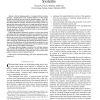101
Voted
RTAS
1999
IEEE
15 years 4 months ago
1999
IEEE
Unique challenges are present when one tries to build distributed real-time applications using standard o -the-shelf systems which are in common use but are not necessarily design...
139
click to vote
IPPS
1999
IEEE
15 years 4 months ago
1999
IEEE
This paper deals with large, distributed real-time systems that have execution times and resource utilizations which cannot be characterized a priori. (The motivation for our work ...
119
Voted
IPPS
1999
IEEE
15 years 4 months ago
1999
IEEE
Some classes of real-time systems function in environments which cannot be modeled with static approaches. In such environments, the arrival rates of events which drive transient ...
103
Voted
IPPS
1999
IEEE
15 years 4 months ago
1999
IEEE
In a real-time system, tasks are constrained by global endto-end (E-T-E) deadlines. In order to cater for high task schedulability, these deadlines must be distributed over compon...
90
Voted
ISSTA
2000
ACM
15 years 4 months ago
2000
ACM
—Before designing safety- or mission-critical real-time systems, a specification of the required behavior of the system should be produced and reviewed by domain experts. After ...
92
Voted
ISSTA
2000
ACM
15 years 4 months ago
2000
ACM
This paper presents three sets of classification schemes for processes, properties, and transitions that can be used to assist in the analysis of real-time systems. These classifi...
155
click to vote
RTSS
2000
IEEE
15 years 4 months ago
2000
IEEE
While early research on real-time computing was concerned with guaranteeing avoidance of undesirable effects such as overload and deadline misses, adaptive real-time systems are d...
81
Voted
RTCSA
2000
IEEE
15 years 4 months ago
2000
IEEE
Large-scale distributed real-time systems are increasingly difficult to analyze within the Rate Monotonic Analysis framework. This is due partly to their heterogeneity, complex i...
106
click to vote
ECRTS
2000
IEEE
15 years 4 months ago
2000
IEEE
This paper describes a methodology for the development of real-time systems and shows its application to the modeling, analysis and implementation of distributed multimedia system...
73
Voted
ECRTS
2000
IEEE
15 years 4 months ago
2000
IEEE
Real-time Systems, in particular regulation systems, are often specified using the notion of running modes. On the other hand, the family of synchronous languages [1] has been ve...






